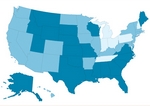Government
Medicaid, CHIP access expanded in 26 states
■ But 15 states put curbs on one or both of the programs in 2009. Some increased CHIP premiums; others froze enrollments.
By Doug Trapp — Posted Dec. 21, 2009
- WITH THIS STORY:
- » Medicaid eligibility thresholds
- » Few childless adults in Medicaid
- » Related content
More states expanded access to Medicaid and the Children's Health Insurance Program in 2009 than restricted it, a recent report concluded.
Twenty-six states improved access to the programs in a few major ways, including simplifying enrollment, loosening income eligibility limits, and expanding programs to cover legal immigrants who have been in the United States for less than five years. That's according to the ninth annual survey on state Medicaid and CHIP programs by the Kaiser Commission on Medicaid and the Uninsured and the Center on Budget and Policy Priorities.
"I'm surprised that [such an increase] has been as substantial as it has, considering the recession," said Diane Rowland, PhD, executive vice president of the Kaiser Family Foundation.
Children benefited the most, said Donna Cohen Ross, a survey co-author and director of outreach for the Center on Budget and Policy Priorities, a nonprofit liberal think tank. Nineteen states eased access for kids in at least one way, including through wider eligibility.
For example, on Oct. 1, Oregon expanded its CHIP eligibility limit to 200% of the federal poverty line, an increase of 15 percentage points. The state also will subsidize private insurance for kids in families earning up to 300% of poverty. The moves are expected to cover an additional 80,000 children in the next 12 months, according to Oregon CHIP Manager Cathy Kaufmann.
But 15 states modestly or significantly curbed access to public health programs, with CHIP the target of nearly all of the cuts. Tennessee froze CHIP enrollment indefinitely on Dec. 1, and California closed enrollment for about two months over the summer. Fourteen states increased CHIP premiums, most by moderate amounts.
State expansions were influenced by provisions in the CHIP reauthorization and the American Recovery and Reinvestment Act, both enacted in February, the report found. Medicaid remained untouched or was expanded in many states due to provisions in the stimulus act that require states receiving federal dollars to maintain or restore Medicaid eligibility and renewal procedures to that of July 1, 2008. That provision did not apply to CHIP.
Still, the CHIP reauthorization offers potentially millions in bonus payments, beginning in late December, to states that meet or exceed Medicaid enrollment targets and implement at least five of eight options to reduce enrollment barriers to the programs. One such option is eliminating in-person interview requirements for people applying for coverage or renewing it. Another is ending asset tests. Sixteen states have applied for the bonuses as of Dec. 3, the report found.
This and other reauthorization provisions greatly encouraged states to reach out to the 5 million children who are eligible for the programs but are not enrolled, Cohen Ross said. "There was new energy around that."
Medicaid expansion worries
Adults' Medicaid coverage continues to lag behind children's coverage, the report found. Census figures indicate the number of uninsured kids decreased by 800,000 in 2008, with government programs largely responsible for the decline. But Medicaid eligibility limits are much tighter for low-income parents than for children.
"The parents have been less well-taken care of over time," Rowland said. So it's not a surprise to see Congress talking about expanding coverage for adults, she said.
Both the House and Senate health system reform bills would expand Medicaid to cover an additional 15 million people, according to Congressional Budget Office estimates. The pending Senate bill would increase Medicaid eligibility across the board to 133% of the federal poverty level beginning in 2014; the House-passed measure would expand eligibility to 150% of poverty the same year.
But Alabama Medicaid Commissioner Carol Steckel said the two bills are moving through Congress too quickly for Medicaid directors and others to understand their potential impact. "The speed by which it's being done is dangerous."
For example, Alabama would have to track people covered by any expansion separately, because the federal government would pay a greater share of the costs for new enrollees. Also, the state would have to process thousands of new applications. "All of that is going to be a significant administrative cost that no one has accounted for," Steckel said.
Asking states to help cover the costs of such a huge Medicaid expansion is bound to cause conflict, she said. "What you're doing is pitting the Medicaid program against public safety, against corrections." Steckel said Alabama would be responsible for millions in new spending, even with the federal government paying about 95% of the cost.












